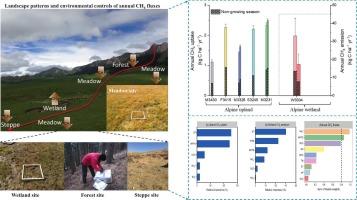Temporal-spatial characteristics and environmental controls of annual CH4 fluxes in a Tibetan alpine landscape
IF 6.6
1区 农林科学
Q1 SOIL SCIENCE
引用次数: 0
Abstract
Alpine ecosystems on the Tibetan Plateau are characterized by different soil hydrothermal conditions and vegetation composition across the elevation gradient, and contribute differently to the net landscape methane (CH4) budget. However, the spatiotemporal variation of CH4 fluxes from alpine ecosystems remains poorly understood, underpinning the uncertainty of upscaling the regional and global CH4 budgets. Here, we investigated the spatial and temporal patterns and environmental controls of CH4 fluxes over two years across a Tibetan alpine landscape spanning different elevations (spanning 3200–3500 m above sea level) and major ecosystem types (including alpine meadow, steppe, forest and wetland). On the annual scale, all alpine upland (meadow, steppe and forest) ecosystems consistently functioned as soil CH4 sinks, ranging between 1.12 and 2.49 kg C ha−1 yr−1, whereas alpine wetlands emitted 17.2–34.3 kg C ha−1 yr−1 to the atmosphere. Non-growing season CH4 fluxes accounted for 29–46 % of the annual budgets, underscoring its significant contribution that was often neglected in previous studies. Our study also demonstrated that for individual alpine upland and wetland ecosystems, soil water content and soil temperature were the main factors regulating the seasonal patterns of CH4 fluxes. While across all alpine ecosystems, soil water content outweighed temperature as the primary control on the landscape patterns of CH4 fluxes and higher wetland CH4 emissions were associated with increased soil inorganic N availability. Despite their small area contribution to the landscape, alpine wetlands emitted disproportionate amounts of CH4, weakening the landscape CH4 sink. The resulting net landscape CH4 balance was a weak sink of 0.72 kg C ha−1 yr−1. Overall, the multiple parameters and insights gained from our study provide valuable information for better predicting the role of alpine ecosystem CH4 carbon-climate feedbacks in high-altitude regions.

然而,高寒生态系统CH4通量的时空变化仍然知之甚少,这为扩大区域和全球CH4预算提供了不确定性。在年尺度上,所有高寒高地(草甸、草原和森林)生态系统都具有土壤CH4汇的功能,向大气排放的CH4在1.12 ~ 2.49 kg C ha−1 yr−1之间,而高寒湿地向大气排放的CH4在17.2 ~ 34.3 kg C ha−1 yr−1之间。非生长期CH4通量占年度预算的29 - 46%,强调了其在以前的研究中经常被忽视的重要贡献。研究还表明,对于个别高寒高原和湿地生态系统,土壤含水量和土壤温度是调节CH4通量季节格局的主要因子。而在所有高寒生态系统中,土壤含水量超过温度是CH4通量景观格局的主要控制因素,湿地CH4排放量的增加与土壤无机氮有效性的增加有关。尽管高寒湿地对景观的贡献面积较小,但其排放的CH4量不成比例,削弱了景观的CH4汇。由此产生的净景观CH4平衡为0.72 kg C ha - 1 yr - 1的弱汇。综上所述,本研究获得的多个参数和见解为更好地预测高海拔地区高寒生态系统CH4碳-气候反馈的作用提供了有价值的信息。
本文章由计算机程序翻译,如有差异,请以英文原文为准。
求助全文
约1分钟内获得全文
求助全文
来源期刊

Geoderma
农林科学-土壤科学
CiteScore
11.80
自引率
6.60%
发文量
597
审稿时长
58 days
期刊介绍:
Geoderma - the global journal of soil science - welcomes authors, readers and soil research from all parts of the world, encourages worldwide soil studies, and embraces all aspects of soil science and its associated pedagogy. The journal particularly welcomes interdisciplinary work focusing on dynamic soil processes and functions across space and time.
 求助内容:
求助内容: 应助结果提醒方式:
应助结果提醒方式:


